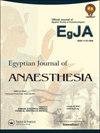Dexmedetomidine versus magnesium sulfate for controlled hypotension during rhinoplasty surgeries: A prospective randomized comparative study
IF 0.5
Q3 ANESTHESIOLOGY
引用次数: 0
Abstract
ABSTRACT Background General anesthesia organizes the best option for controlled blood pressure during rhinoplasty surgery. The primary agent applied in controlling hypotension should have particular unique characteristics. The peripheral and central sympatholytic attainment of dexmedetomidine is usually indicated by low blood pressure and low heart rate. Magnesium sulfate is among the best agents used. Objective Determine the influence of both dexmedetomidine and magnesium sulfate on hemodynamic parameters for patients undergoing rhinoplasty surgeries after general anesthesia. Patients and methods This is a randomized prospective comparative study. Fifty-six patients got enrolled and divided into two categories. Group 1 (n = 28): Received a priming dose of dexmedetomidine 1 microgram/kg before induction then 0.4 µg/kg/h. Group 2 (n = 28): Received 30 mg/kg of magnesium sulfate as a priming dose before induction and then 10 mg/kg/h during the time of the procedure. Results No significant differences were seen between the two groups regarding the MAP. There were significant differences among the groups in heart rate (p < 0.05). The patients in the second group experienced higher bleeding scores than those in the first group. The first group had a higher surgeon satisfaction rate than the second group (p < 0.05). The first group had more time to arrive at the Aldrete score of less than or equal to 9 than that of the second group of patients. Conclusion Dexmedetomidine has high effectiveness in attaining controlled hypotension in patients undergoing rhinoplasty. Magnesium sulfate requires extra nitroglycerine. Dexmedetomidine possesses a potent analgesic impact with a reduced analgesic requirement duration compared to magnesium sulfate. Registration trial The study was approved by clinical trials registration (NCT05880693).右美托咪定与硫酸镁在鼻整形手术中控制低血压:一项前瞻性随机比较研究
本文章由计算机程序翻译,如有差异,请以英文原文为准。
求助全文
约1分钟内获得全文
求助全文
来源期刊

Egyptian Journal of Anaesthesia
Medicine-Anesthesiology and Pain Medicine
CiteScore
0.90
自引率
0.00%
发文量
78
 求助内容:
求助内容: 应助结果提醒方式:
应助结果提醒方式:


